Comprehensive Analysis of Law of Business Organization
VerifiedAdded on 2023/06/03
|10
|1916
|287
Report
AI Summary
This report provides a legal analysis of two key issues in business organizations. The first issue involves JCI Ltd and the legal ramifications of a terminated employee's misrepresentation in a contract with Anglo-American Corp Ltd, focusing on contract law, misrepresentation, and the lack of authority. The second issue concerns Ringo, a shareholder, and the remedies available to him for the misconduct of other shareholders and directors, covering shareholder rights, resolutions, director duties, and violations of the Corporations Act 2001. The report examines the legal principles, relevant legislation, and potential outcomes for each scenario, including potential liabilities, remedies, and penalties under Australian law. It also discusses the importance of proper procedures for passing resolutions and the responsibilities of directors to shareholders.
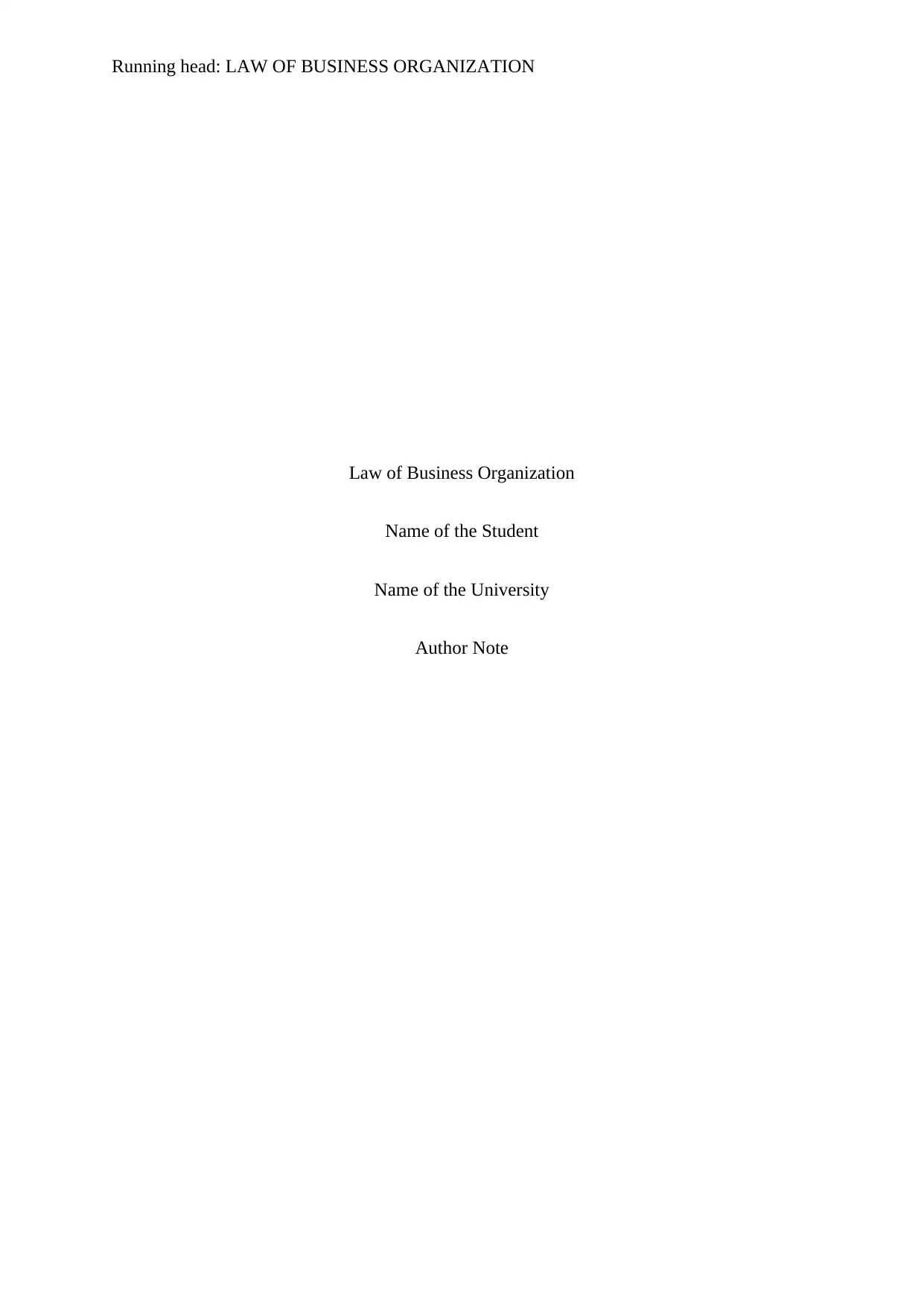
Running head: LAW OF BUSINESS ORGANIZATION
Law of Business Organization
Name of the Student
Name of the University
Author Note
Law of Business Organization
Name of the Student
Name of the University
Author Note
Paraphrase This Document
Need a fresh take? Get an instant paraphrase of this document with our AI Paraphraser
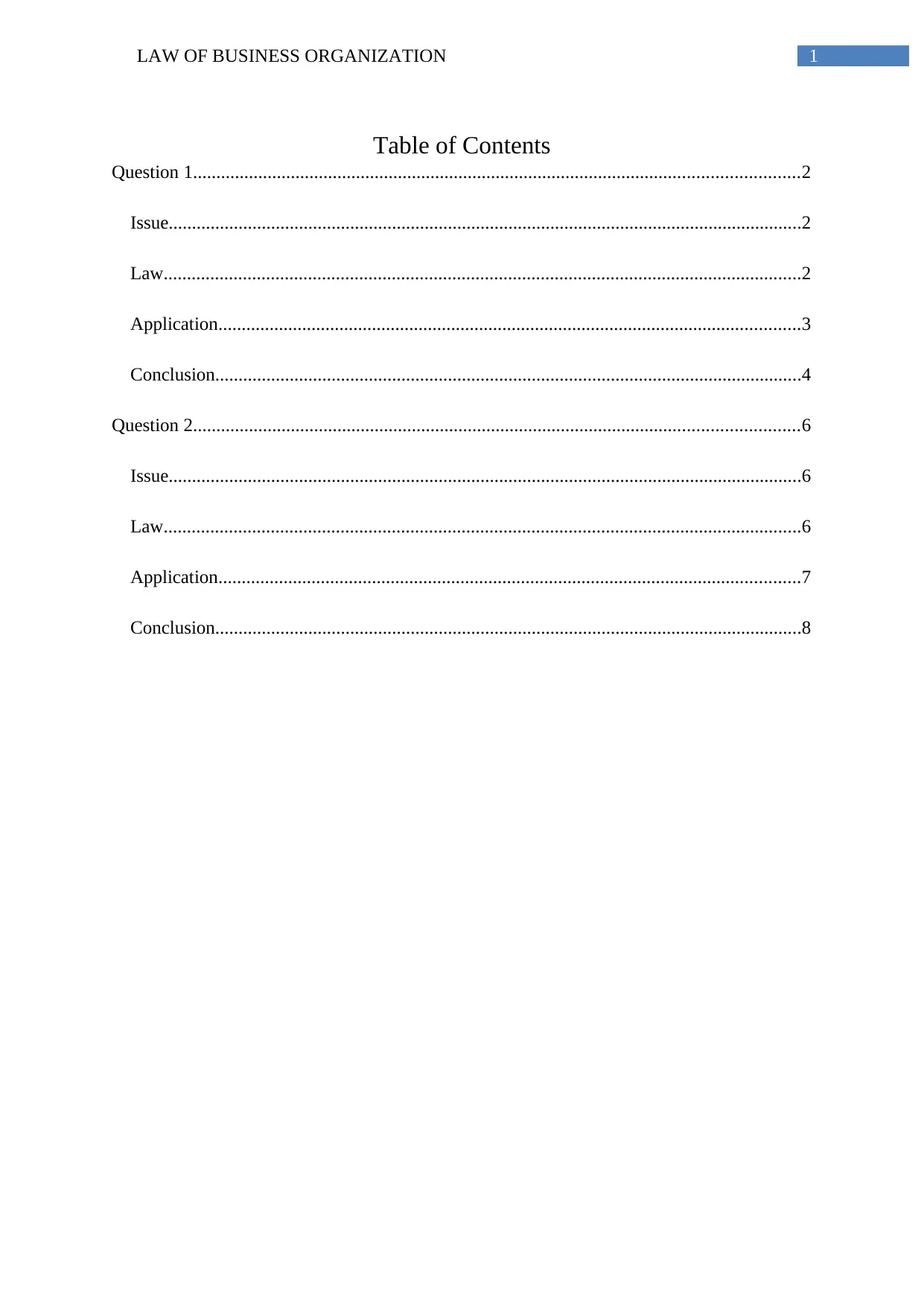
1LAW OF BUSINESS ORGANIZATION
Table of Contents
Question 1..................................................................................................................................2
Issue........................................................................................................................................2
Law.........................................................................................................................................2
Application.............................................................................................................................3
Conclusion..............................................................................................................................4
Question 2..................................................................................................................................6
Issue........................................................................................................................................6
Law.........................................................................................................................................6
Application.............................................................................................................................7
Conclusion..............................................................................................................................8
Table of Contents
Question 1..................................................................................................................................2
Issue........................................................................................................................................2
Law.........................................................................................................................................2
Application.............................................................................................................................3
Conclusion..............................................................................................................................4
Question 2..................................................................................................................................6
Issue........................................................................................................................................6
Law.........................................................................................................................................6
Application.............................................................................................................................7
Conclusion..............................................................................................................................8
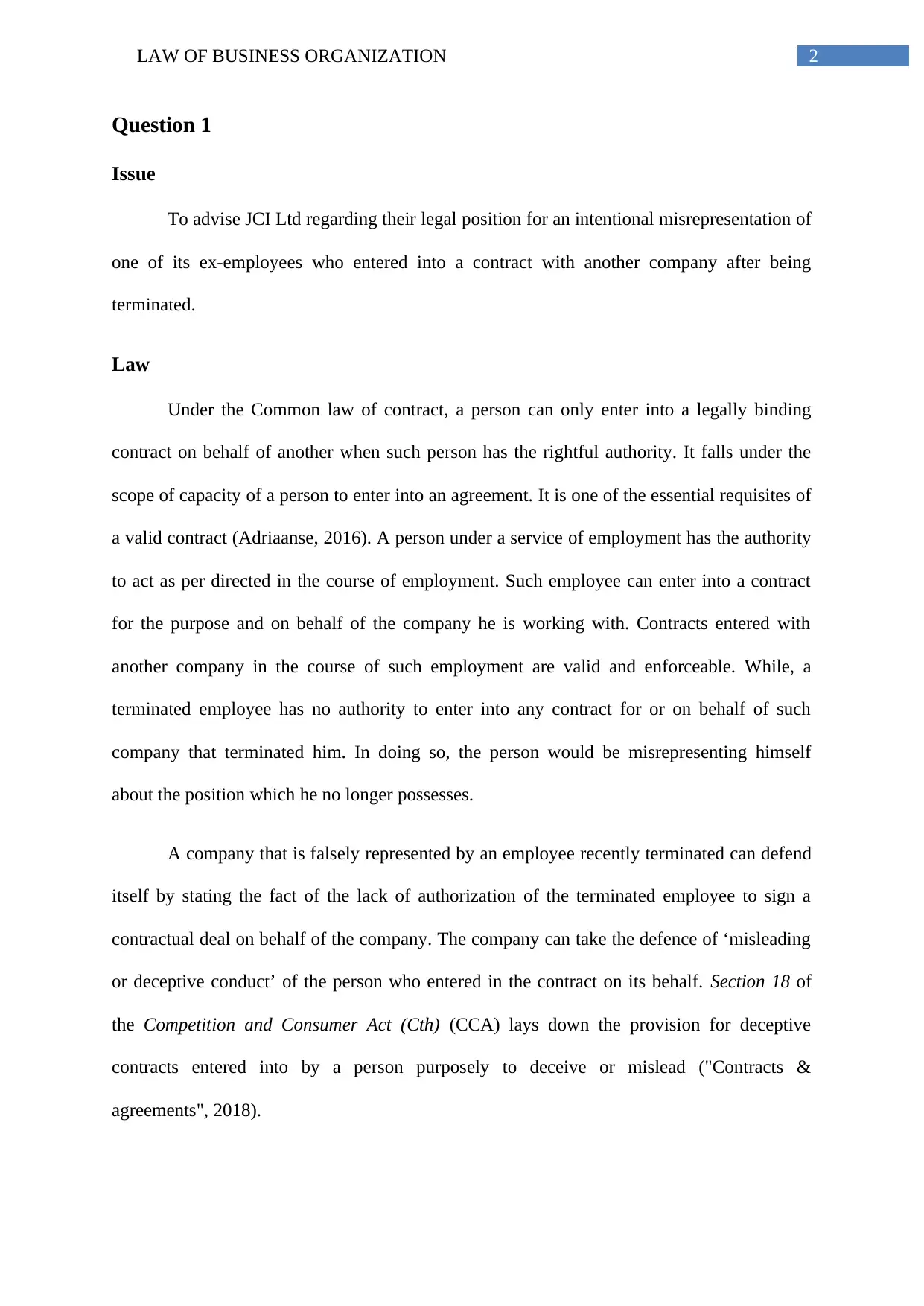
2LAW OF BUSINESS ORGANIZATION
Question 1
Issue
To advise JCI Ltd regarding their legal position for an intentional misrepresentation of
one of its ex-employees who entered into a contract with another company after being
terminated.
Law
Under the Common law of contract, a person can only enter into a legally binding
contract on behalf of another when such person has the rightful authority. It falls under the
scope of capacity of a person to enter into an agreement. It is one of the essential requisites of
a valid contract (Adriaanse, 2016). A person under a service of employment has the authority
to act as per directed in the course of employment. Such employee can enter into a contract
for the purpose and on behalf of the company he is working with. Contracts entered with
another company in the course of such employment are valid and enforceable. While, a
terminated employee has no authority to enter into any contract for or on behalf of such
company that terminated him. In doing so, the person would be misrepresenting himself
about the position which he no longer possesses.
A company that is falsely represented by an employee recently terminated can defend
itself by stating the fact of the lack of authorization of the terminated employee to sign a
contractual deal on behalf of the company. The company can take the defence of ‘misleading
or deceptive conduct’ of the person who entered in the contract on its behalf. Section 18 of
the Competition and Consumer Act (Cth) (CCA) lays down the provision for deceptive
contracts entered into by a person purposely to deceive or mislead ("Contracts &
agreements", 2018).
Question 1
Issue
To advise JCI Ltd regarding their legal position for an intentional misrepresentation of
one of its ex-employees who entered into a contract with another company after being
terminated.
Law
Under the Common law of contract, a person can only enter into a legally binding
contract on behalf of another when such person has the rightful authority. It falls under the
scope of capacity of a person to enter into an agreement. It is one of the essential requisites of
a valid contract (Adriaanse, 2016). A person under a service of employment has the authority
to act as per directed in the course of employment. Such employee can enter into a contract
for the purpose and on behalf of the company he is working with. Contracts entered with
another company in the course of such employment are valid and enforceable. While, a
terminated employee has no authority to enter into any contract for or on behalf of such
company that terminated him. In doing so, the person would be misrepresenting himself
about the position which he no longer possesses.
A company that is falsely represented by an employee recently terminated can defend
itself by stating the fact of the lack of authorization of the terminated employee to sign a
contractual deal on behalf of the company. The company can take the defence of ‘misleading
or deceptive conduct’ of the person who entered in the contract on its behalf. Section 18 of
the Competition and Consumer Act (Cth) (CCA) lays down the provision for deceptive
contracts entered into by a person purposely to deceive or mislead ("Contracts &
agreements", 2018).
⊘ This is a preview!⊘
Do you want full access?
Subscribe today to unlock all pages.

Trusted by 1+ million students worldwide
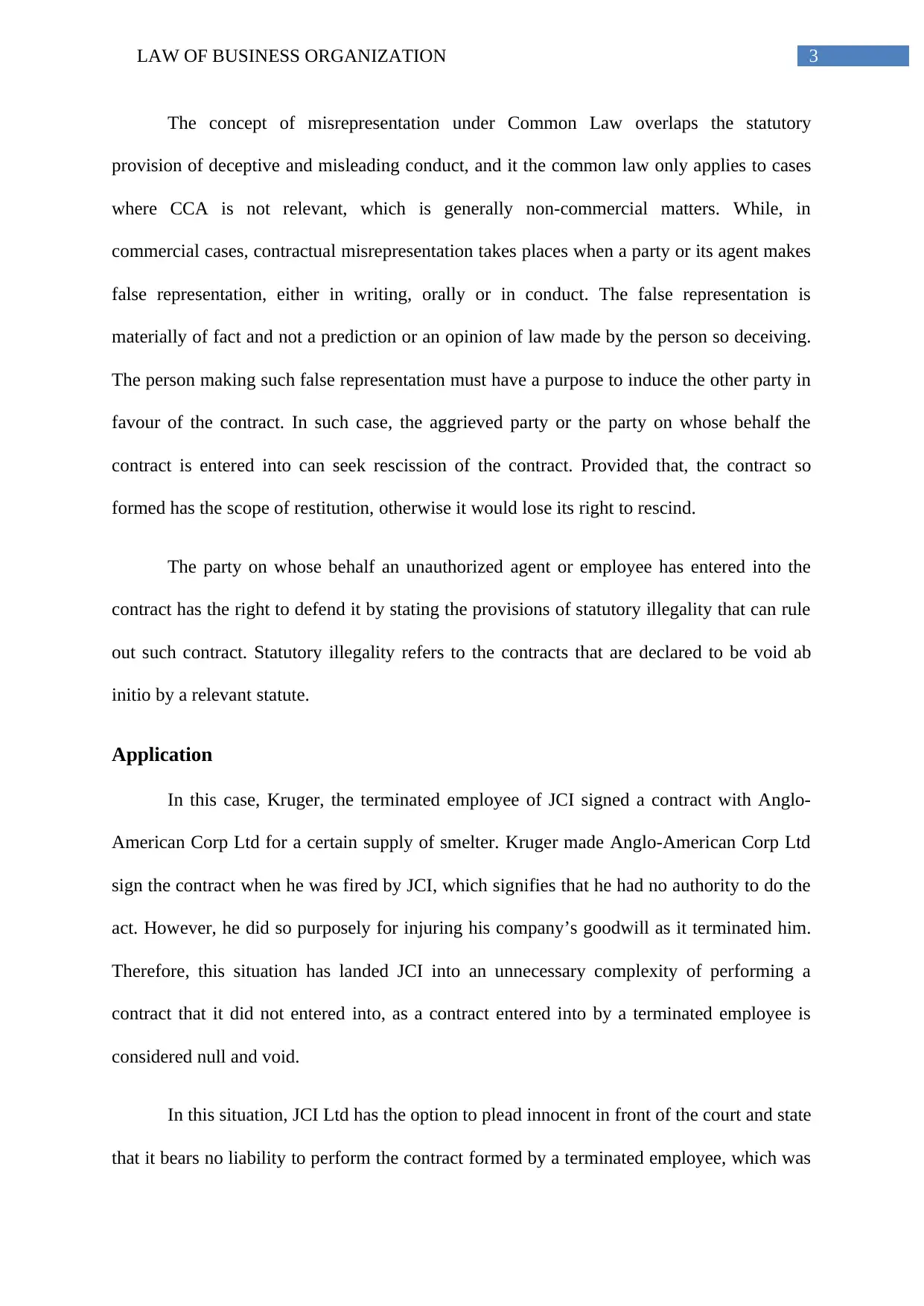
3LAW OF BUSINESS ORGANIZATION
The concept of misrepresentation under Common Law overlaps the statutory
provision of deceptive and misleading conduct, and it the common law only applies to cases
where CCA is not relevant, which is generally non-commercial matters. While, in
commercial cases, contractual misrepresentation takes places when a party or its agent makes
false representation, either in writing, orally or in conduct. The false representation is
materially of fact and not a prediction or an opinion of law made by the person so deceiving.
The person making such false representation must have a purpose to induce the other party in
favour of the contract. In such case, the aggrieved party or the party on whose behalf the
contract is entered into can seek rescission of the contract. Provided that, the contract so
formed has the scope of restitution, otherwise it would lose its right to rescind.
The party on whose behalf an unauthorized agent or employee has entered into the
contract has the right to defend it by stating the provisions of statutory illegality that can rule
out such contract. Statutory illegality refers to the contracts that are declared to be void ab
initio by a relevant statute.
Application
In this case, Kruger, the terminated employee of JCI signed a contract with Anglo-
American Corp Ltd for a certain supply of smelter. Kruger made Anglo-American Corp Ltd
sign the contract when he was fired by JCI, which signifies that he had no authority to do the
act. However, he did so purposely for injuring his company’s goodwill as it terminated him.
Therefore, this situation has landed JCI into an unnecessary complexity of performing a
contract that it did not entered into, as a contract entered into by a terminated employee is
considered null and void.
In this situation, JCI Ltd has the option to plead innocent in front of the court and state
that it bears no liability to perform the contract formed by a terminated employee, which was
The concept of misrepresentation under Common Law overlaps the statutory
provision of deceptive and misleading conduct, and it the common law only applies to cases
where CCA is not relevant, which is generally non-commercial matters. While, in
commercial cases, contractual misrepresentation takes places when a party or its agent makes
false representation, either in writing, orally or in conduct. The false representation is
materially of fact and not a prediction or an opinion of law made by the person so deceiving.
The person making such false representation must have a purpose to induce the other party in
favour of the contract. In such case, the aggrieved party or the party on whose behalf the
contract is entered into can seek rescission of the contract. Provided that, the contract so
formed has the scope of restitution, otherwise it would lose its right to rescind.
The party on whose behalf an unauthorized agent or employee has entered into the
contract has the right to defend it by stating the provisions of statutory illegality that can rule
out such contract. Statutory illegality refers to the contracts that are declared to be void ab
initio by a relevant statute.
Application
In this case, Kruger, the terminated employee of JCI signed a contract with Anglo-
American Corp Ltd for a certain supply of smelter. Kruger made Anglo-American Corp Ltd
sign the contract when he was fired by JCI, which signifies that he had no authority to do the
act. However, he did so purposely for injuring his company’s goodwill as it terminated him.
Therefore, this situation has landed JCI into an unnecessary complexity of performing a
contract that it did not entered into, as a contract entered into by a terminated employee is
considered null and void.
In this situation, JCI Ltd has the option to plead innocent in front of the court and state
that it bears no liability to perform the contract formed by a terminated employee, which was
Paraphrase This Document
Need a fresh take? Get an instant paraphrase of this document with our AI Paraphraser
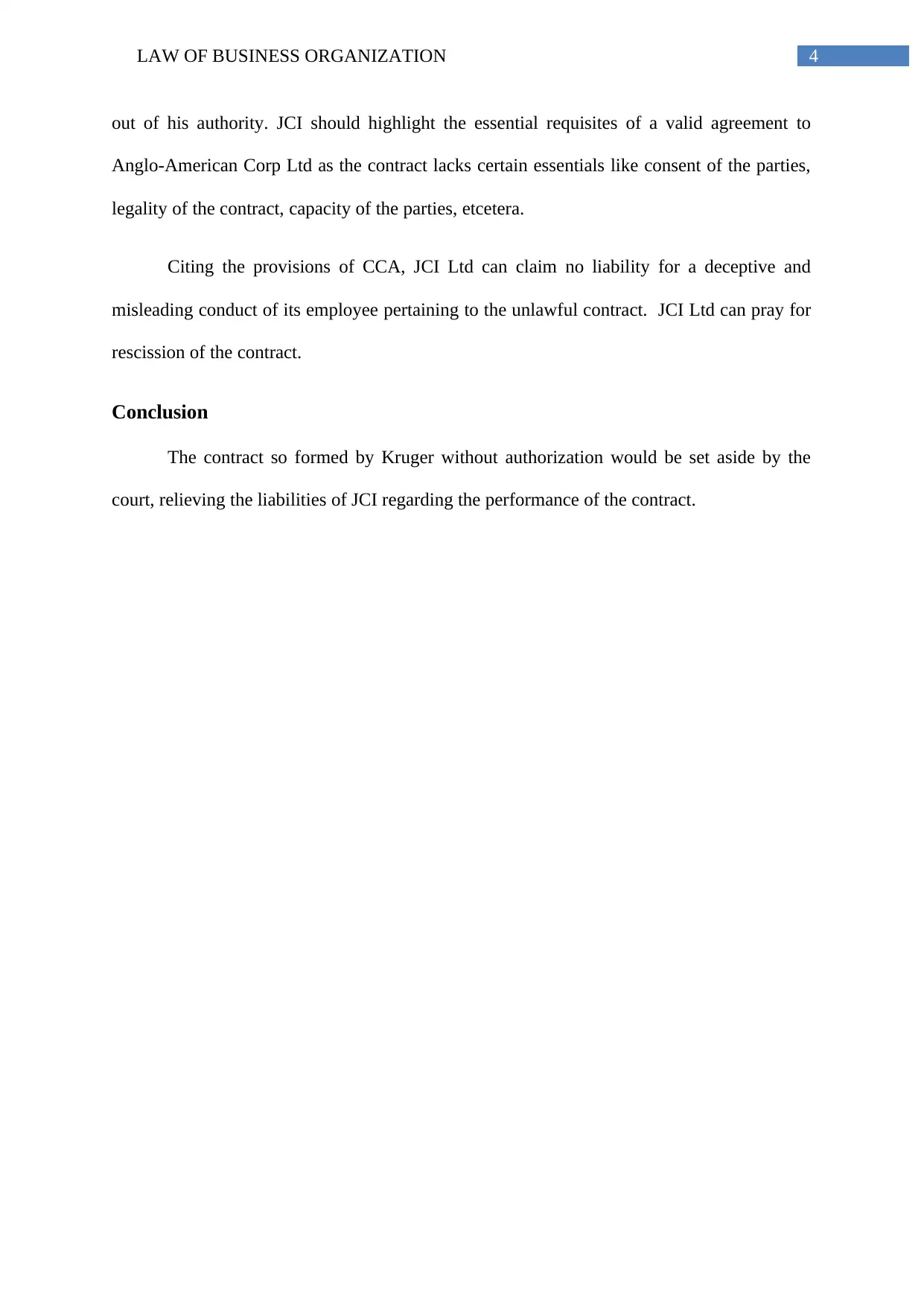
4LAW OF BUSINESS ORGANIZATION
out of his authority. JCI should highlight the essential requisites of a valid agreement to
Anglo-American Corp Ltd as the contract lacks certain essentials like consent of the parties,
legality of the contract, capacity of the parties, etcetera.
Citing the provisions of CCA, JCI Ltd can claim no liability for a deceptive and
misleading conduct of its employee pertaining to the unlawful contract. JCI Ltd can pray for
rescission of the contract.
Conclusion
The contract so formed by Kruger without authorization would be set aside by the
court, relieving the liabilities of JCI regarding the performance of the contract.
out of his authority. JCI should highlight the essential requisites of a valid agreement to
Anglo-American Corp Ltd as the contract lacks certain essentials like consent of the parties,
legality of the contract, capacity of the parties, etcetera.
Citing the provisions of CCA, JCI Ltd can claim no liability for a deceptive and
misleading conduct of its employee pertaining to the unlawful contract. JCI Ltd can pray for
rescission of the contract.
Conclusion
The contract so formed by Kruger without authorization would be set aside by the
court, relieving the liabilities of JCI regarding the performance of the contract.

5LAW OF BUSINESS ORGANIZATION
References
Adriaanse, M. J. (2016). Construction contract law. Macmillan International Higher
Education.
Contracts & agreements. (2018). Retrieved from
https://www.accc.gov.au/consumers/contracts-agreements
References
Adriaanse, M. J. (2016). Construction contract law. Macmillan International Higher
Education.
Contracts & agreements. (2018). Retrieved from
https://www.accc.gov.au/consumers/contracts-agreements
⊘ This is a preview!⊘
Do you want full access?
Subscribe today to unlock all pages.

Trusted by 1+ million students worldwide
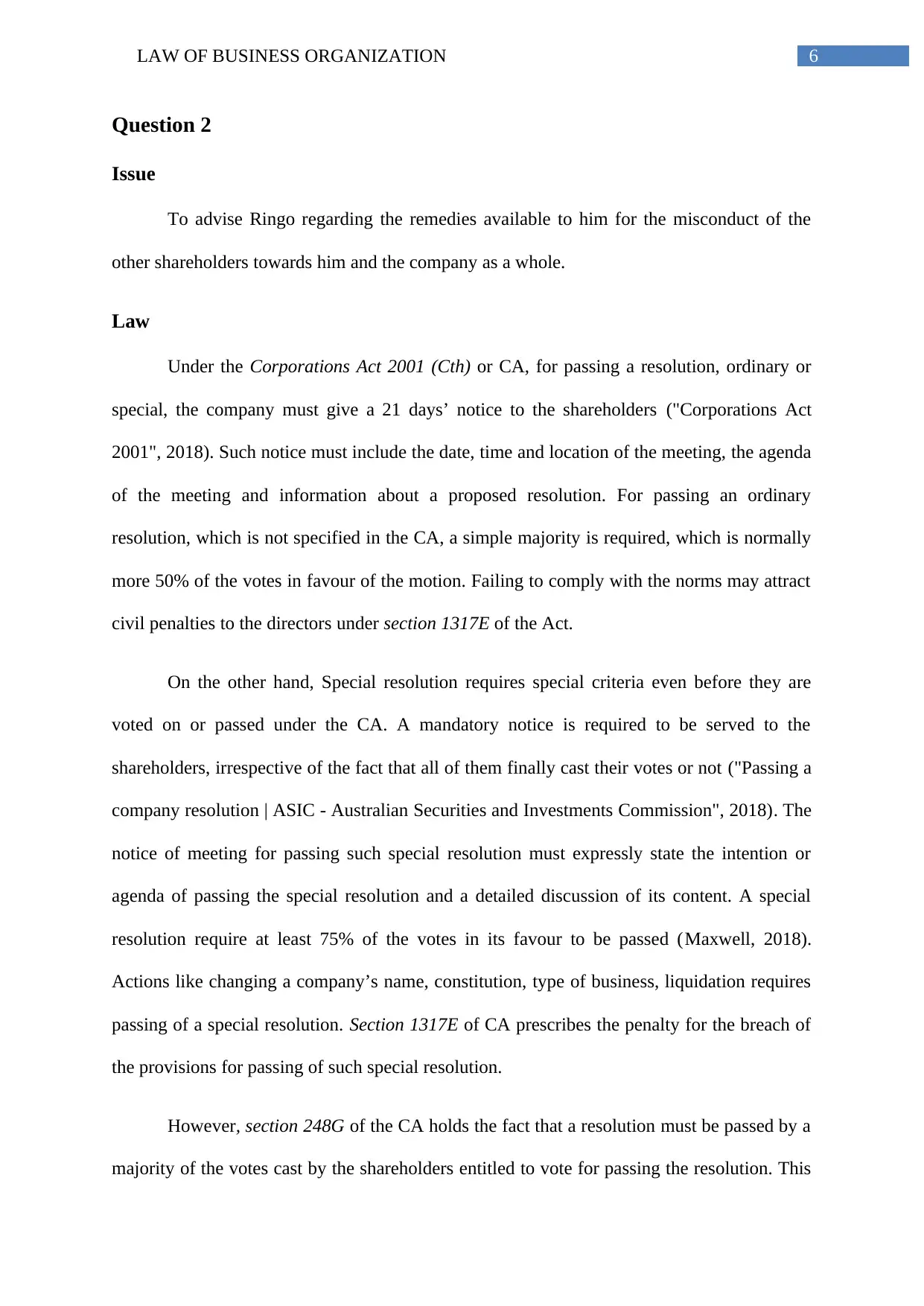
6LAW OF BUSINESS ORGANIZATION
Question 2
Issue
To advise Ringo regarding the remedies available to him for the misconduct of the
other shareholders towards him and the company as a whole.
Law
Under the Corporations Act 2001 (Cth) or CA, for passing a resolution, ordinary or
special, the company must give a 21 days’ notice to the shareholders ("Corporations Act
2001", 2018). Such notice must include the date, time and location of the meeting, the agenda
of the meeting and information about a proposed resolution. For passing an ordinary
resolution, which is not specified in the CA, a simple majority is required, which is normally
more 50% of the votes in favour of the motion. Failing to comply with the norms may attract
civil penalties to the directors under section 1317E of the Act.
On the other hand, Special resolution requires special criteria even before they are
voted on or passed under the CA. A mandatory notice is required to be served to the
shareholders, irrespective of the fact that all of them finally cast their votes or not ("Passing a
company resolution | ASIC - Australian Securities and Investments Commission", 2018). The
notice of meeting for passing such special resolution must expressly state the intention or
agenda of passing the special resolution and a detailed discussion of its content. A special
resolution require at least 75% of the votes in its favour to be passed (Maxwell, 2018).
Actions like changing a company’s name, constitution, type of business, liquidation requires
passing of a special resolution. Section 1317E of CA prescribes the penalty for the breach of
the provisions for passing of such special resolution.
However, section 248G of the CA holds the fact that a resolution must be passed by a
majority of the votes cast by the shareholders entitled to vote for passing the resolution. This
Question 2
Issue
To advise Ringo regarding the remedies available to him for the misconduct of the
other shareholders towards him and the company as a whole.
Law
Under the Corporations Act 2001 (Cth) or CA, for passing a resolution, ordinary or
special, the company must give a 21 days’ notice to the shareholders ("Corporations Act
2001", 2018). Such notice must include the date, time and location of the meeting, the agenda
of the meeting and information about a proposed resolution. For passing an ordinary
resolution, which is not specified in the CA, a simple majority is required, which is normally
more 50% of the votes in favour of the motion. Failing to comply with the norms may attract
civil penalties to the directors under section 1317E of the Act.
On the other hand, Special resolution requires special criteria even before they are
voted on or passed under the CA. A mandatory notice is required to be served to the
shareholders, irrespective of the fact that all of them finally cast their votes or not ("Passing a
company resolution | ASIC - Australian Securities and Investments Commission", 2018). The
notice of meeting for passing such special resolution must expressly state the intention or
agenda of passing the special resolution and a detailed discussion of its content. A special
resolution require at least 75% of the votes in its favour to be passed (Maxwell, 2018).
Actions like changing a company’s name, constitution, type of business, liquidation requires
passing of a special resolution. Section 1317E of CA prescribes the penalty for the breach of
the provisions for passing of such special resolution.
However, section 248G of the CA holds the fact that a resolution must be passed by a
majority of the votes cast by the shareholders entitled to vote for passing the resolution. This
Paraphrase This Document
Need a fresh take? Get an instant paraphrase of this document with our AI Paraphraser
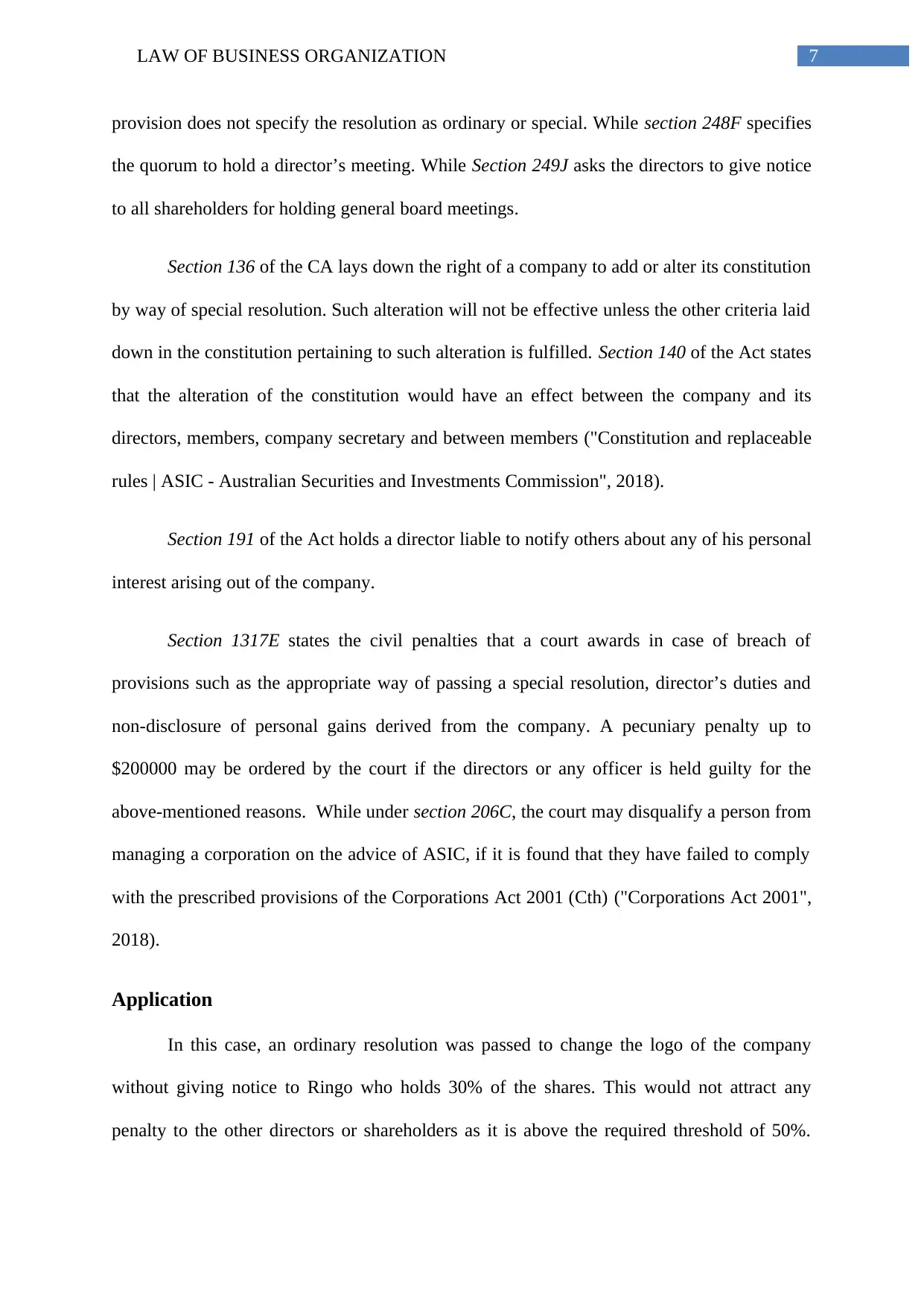
7LAW OF BUSINESS ORGANIZATION
provision does not specify the resolution as ordinary or special. While section 248F specifies
the quorum to hold a director’s meeting. While Section 249J asks the directors to give notice
to all shareholders for holding general board meetings.
Section 136 of the CA lays down the right of a company to add or alter its constitution
by way of special resolution. Such alteration will not be effective unless the other criteria laid
down in the constitution pertaining to such alteration is fulfilled. Section 140 of the Act states
that the alteration of the constitution would have an effect between the company and its
directors, members, company secretary and between members ("Constitution and replaceable
rules | ASIC - Australian Securities and Investments Commission", 2018).
Section 191 of the Act holds a director liable to notify others about any of his personal
interest arising out of the company.
Section 1317E states the civil penalties that a court awards in case of breach of
provisions such as the appropriate way of passing a special resolution, director’s duties and
non-disclosure of personal gains derived from the company. A pecuniary penalty up to
$200000 may be ordered by the court if the directors or any officer is held guilty for the
above-mentioned reasons. While under section 206C, the court may disqualify a person from
managing a corporation on the advice of ASIC, if it is found that they have failed to comply
with the prescribed provisions of the Corporations Act 2001 (Cth) ("Corporations Act 2001",
2018).
Application
In this case, an ordinary resolution was passed to change the logo of the company
without giving notice to Ringo who holds 30% of the shares. This would not attract any
penalty to the other directors or shareholders as it is above the required threshold of 50%.
provision does not specify the resolution as ordinary or special. While section 248F specifies
the quorum to hold a director’s meeting. While Section 249J asks the directors to give notice
to all shareholders for holding general board meetings.
Section 136 of the CA lays down the right of a company to add or alter its constitution
by way of special resolution. Such alteration will not be effective unless the other criteria laid
down in the constitution pertaining to such alteration is fulfilled. Section 140 of the Act states
that the alteration of the constitution would have an effect between the company and its
directors, members, company secretary and between members ("Constitution and replaceable
rules | ASIC - Australian Securities and Investments Commission", 2018).
Section 191 of the Act holds a director liable to notify others about any of his personal
interest arising out of the company.
Section 1317E states the civil penalties that a court awards in case of breach of
provisions such as the appropriate way of passing a special resolution, director’s duties and
non-disclosure of personal gains derived from the company. A pecuniary penalty up to
$200000 may be ordered by the court if the directors or any officer is held guilty for the
above-mentioned reasons. While under section 206C, the court may disqualify a person from
managing a corporation on the advice of ASIC, if it is found that they have failed to comply
with the prescribed provisions of the Corporations Act 2001 (Cth) ("Corporations Act 2001",
2018).
Application
In this case, an ordinary resolution was passed to change the logo of the company
without giving notice to Ringo who holds 30% of the shares. This would not attract any
penalty to the other directors or shareholders as it is above the required threshold of 50%.
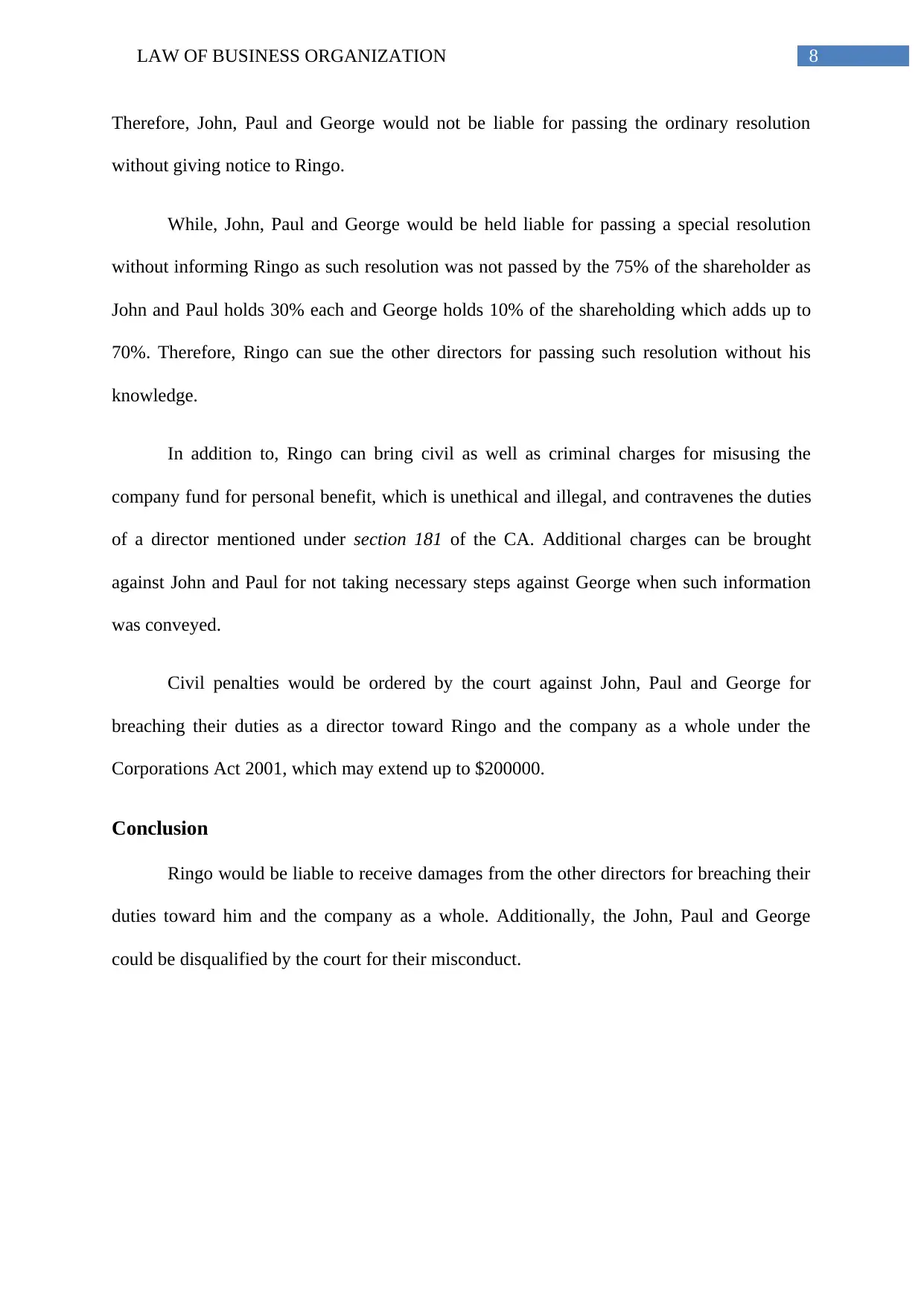
8LAW OF BUSINESS ORGANIZATION
Therefore, John, Paul and George would not be liable for passing the ordinary resolution
without giving notice to Ringo.
While, John, Paul and George would be held liable for passing a special resolution
without informing Ringo as such resolution was not passed by the 75% of the shareholder as
John and Paul holds 30% each and George holds 10% of the shareholding which adds up to
70%. Therefore, Ringo can sue the other directors for passing such resolution without his
knowledge.
In addition to, Ringo can bring civil as well as criminal charges for misusing the
company fund for personal benefit, which is unethical and illegal, and contravenes the duties
of a director mentioned under section 181 of the CA. Additional charges can be brought
against John and Paul for not taking necessary steps against George when such information
was conveyed.
Civil penalties would be ordered by the court against John, Paul and George for
breaching their duties as a director toward Ringo and the company as a whole under the
Corporations Act 2001, which may extend up to $200000.
Conclusion
Ringo would be liable to receive damages from the other directors for breaching their
duties toward him and the company as a whole. Additionally, the John, Paul and George
could be disqualified by the court for their misconduct.
Therefore, John, Paul and George would not be liable for passing the ordinary resolution
without giving notice to Ringo.
While, John, Paul and George would be held liable for passing a special resolution
without informing Ringo as such resolution was not passed by the 75% of the shareholder as
John and Paul holds 30% each and George holds 10% of the shareholding which adds up to
70%. Therefore, Ringo can sue the other directors for passing such resolution without his
knowledge.
In addition to, Ringo can bring civil as well as criminal charges for misusing the
company fund for personal benefit, which is unethical and illegal, and contravenes the duties
of a director mentioned under section 181 of the CA. Additional charges can be brought
against John and Paul for not taking necessary steps against George when such information
was conveyed.
Civil penalties would be ordered by the court against John, Paul and George for
breaching their duties as a director toward Ringo and the company as a whole under the
Corporations Act 2001, which may extend up to $200000.
Conclusion
Ringo would be liable to receive damages from the other directors for breaching their
duties toward him and the company as a whole. Additionally, the John, Paul and George
could be disqualified by the court for their misconduct.
⊘ This is a preview!⊘
Do you want full access?
Subscribe today to unlock all pages.

Trusted by 1+ million students worldwide
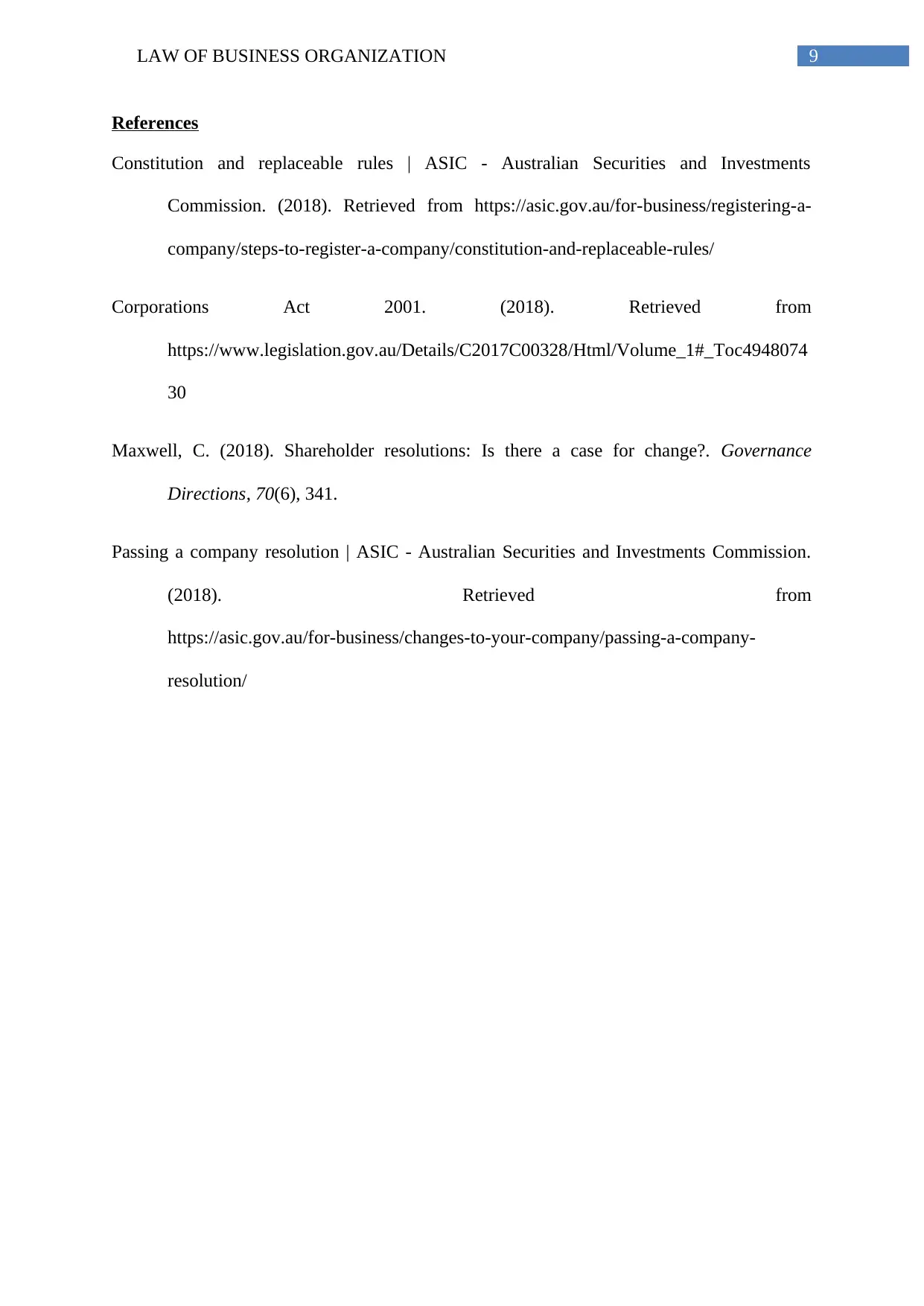
9LAW OF BUSINESS ORGANIZATION
References
Constitution and replaceable rules | ASIC - Australian Securities and Investments
Commission. (2018). Retrieved from https://asic.gov.au/for-business/registering-a-
company/steps-to-register-a-company/constitution-and-replaceable-rules/
Corporations Act 2001. (2018). Retrieved from
https://www.legislation.gov.au/Details/C2017C00328/Html/Volume_1#_Toc4948074
30
Maxwell, C. (2018). Shareholder resolutions: Is there a case for change?. Governance
Directions, 70(6), 341.
Passing a company resolution | ASIC - Australian Securities and Investments Commission.
(2018). Retrieved from
https://asic.gov.au/for-business/changes-to-your-company/passing-a-company-
resolution/
References
Constitution and replaceable rules | ASIC - Australian Securities and Investments
Commission. (2018). Retrieved from https://asic.gov.au/for-business/registering-a-
company/steps-to-register-a-company/constitution-and-replaceable-rules/
Corporations Act 2001. (2018). Retrieved from
https://www.legislation.gov.au/Details/C2017C00328/Html/Volume_1#_Toc4948074
30
Maxwell, C. (2018). Shareholder resolutions: Is there a case for change?. Governance
Directions, 70(6), 341.
Passing a company resolution | ASIC - Australian Securities and Investments Commission.
(2018). Retrieved from
https://asic.gov.au/for-business/changes-to-your-company/passing-a-company-
resolution/
1 out of 10
Related Documents
Your All-in-One AI-Powered Toolkit for Academic Success.
+13062052269
info@desklib.com
Available 24*7 on WhatsApp / Email
![[object Object]](/_next/static/media/star-bottom.7253800d.svg)
Unlock your academic potential
Copyright © 2020–2025 A2Z Services. All Rights Reserved. Developed and managed by ZUCOL.





